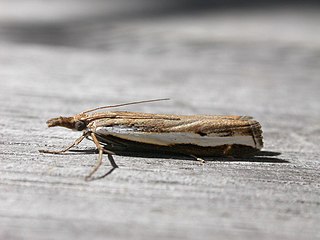
Orocrambus is a genus of moths of the family Crambidae. All species are endemic to New Zealand.

Orocrambus flexuosellus is a species of moth in the family Crambidae. It was first described by Edward Doubleday in 1843. O. flexuosellus is endemic to New Zealand. It has been recorded from the North Island, South Island and the Stewart Islands. The species' habitat consists of lowland to alpine grasslands.
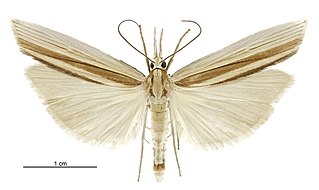
Orocrambus angustipennis is a species of moth in the Crambinae family. It is endemic to New Zealand. O. angustipennis is present in the North Island, South Island and the Chatham Islands.
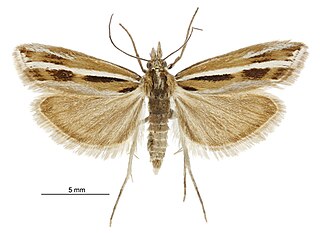
Orocrambus corruptus is a moth in the family Crambidae. It was described by Arthur Gardiner Butler in 1877. It is endemic to New Zealand. It is known from the lowland and intermontane region areas of eastern and central South Island. The habitat consists of poorly drained areas up to 750 meters and old pastures.

Orocrambus cyclopicus is a moth in the family Crambidae. It was described by Edward Meyrick in 1883. In 1975 David E. Gaskin wrongly synonymised Crambus sophistes with Orocrambus cyclopicus.
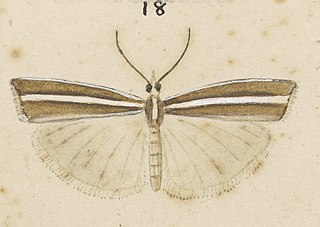
Orocrambus dicrenellus is a moth in the family Crambidae. This species was first described by Edward Meyrick in 1882 under the name Crambus dicrenellus. It is endemic to New Zealand. It has been recorded from the central part of the South Island. The habitat consists of alpine and subalpine tussock grasslands.

Orocrambus enchophorus is a moth in the family Crambidae. It was described by Edward Meyrick in 1885. It is endemic to New Zealand. It has been recorded from the South Island and North Island. The lives in lowland to alpine grassland habitat.

Orocrambus ephorus is a moth in the family Crambidae. It was described by Edward Meyrick in 1885. It is endemic to New Zealand. It has been recorded from the South Island. The species' preferred habitat consists of alpine tussock grasslands.

Orocrambus harpophorus is a moth in the family Crambidae. It was described by Edward Meyrick in 1882. It is endemic to New Zealand. The species has been recorded from the South Island and North Island.

Orocrambus heliotes is a moth in the family Crambidae. It was described by Edward Meyrick in 1888. This species is endemic to New Zealand. O. heliotes has been recorded in the South Island and the North Island. The habitat it prefers consists of swampy tussock grasslands and margins of slow-moving streams.

Orocrambus horistes is a moth in the family Crambidae. It was described by Edward Meyrick in 1902. O. horistes is endemic to New Zealand, where it has only been recorded from the Chatham Islands.

Orocrambus paraxenus is a moth in the family Crambidae. It was described by Edward Meyrick in 1885. It is endemic to New Zealand, where it has been recorded from the South Island. The habitat this species prefers consists of dry tussock areas.

Orocrambus ramosellus is a moth in the family Crambidae. It was described by Henry Doubleday in 1843. It is endemic to New Zealand, where it has been recorded in the North and South Islands. The habitat of this species consists of pastures.
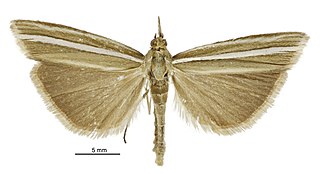
Orocrambus scutatus is a moth in the family Crambidae. It was described by Alfred Philpott in 1917. It is endemic to New Zealand, where it has been recorded in Southland. The habitat of this species consists of subalpine tussock grassland.
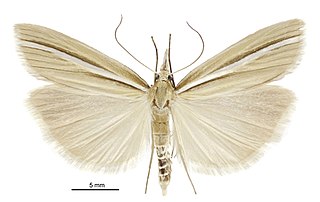
Orocrambus simplex is a moth in the family Crambidae. It was described by Arthur Gardiner Butler in 1877. It is endemic to New Zealand, where it has been recorded in Westland, Nelson Province, the central part of the North Island and the coastal area of southern Hawkes Bay. The habitat where this species lives consists of tussock grasslands.
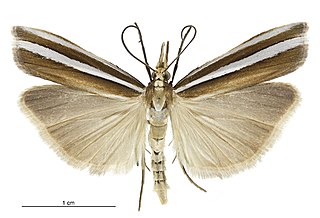
Orocrambus siriellus is a moth in the family Crambidae. It was described by Edward Meyrick in 1883. This species is endemic to New Zealand, where it has been recorded in Northland to Southland and on the Chatham Islands. It lives in habitat consisting of swampy areas.

Orocrambus tritonellus is a moth in the family Crambidae. It was described by Edward Meyrick in 1885. This species is endemic to New Zealand, where it has been recorded in the central and eastern parts of the South Island. This species prefers habitat that consists of subalpine and alpine areas.

Orocrambus tuhualis is a moth in the family Crambidae. It was described by Cajetan Felder, Rudolf Felder and Alois Friedrich Rogenhofer in 1875. It is endemic to New Zealand, where it has been recorded in the South Island and Wellington in the North Island. This species prefers habitat that consists of swampy areas.

Orocrambus vittellus is a moth in the family Crambidae. It was described by Henry Doubleday in 1843. It is endemic to New Zealand. This species has been recorded in the North and South Islands, as well as Stewart Island. It prefers a habitat that consists of grasslands.

Orocrambus xanthogrammus is a moth in the family Crambidae. It was described by Edward Meyrick in 1883. It is endemic to New Zealand, where it has been recorded from the South Island and the eastern part of the North Island. The habitat of this species consists of shingle river beds.





















